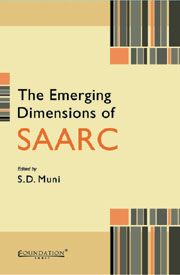Book contents
- Frontmatter
- Contents
- Preface
- List of Figures
- List of Tables
- 1 SAARC Prospects: The Changing Dimensions
- 2 SAARC and South Asian Economic Integration
- 3 Coping with the Emerging Challenges: Poverty and Food Security
- 4 SAARC Energy Cooperation: Energy Security and Environmental Challenges
- 5 Sub-Regional Cooperation under SAARC: An Economic Analysis
- 6 SAARC: Social Charter and Human Security
- 7 SAARC and the South Asian Security Architect
- 8 Fighting Terrorism through SAARC?
- 9 SAARC and the Evolving Asian Regionalism
- 10 Role of SAARC Observers: Members' Perspectives
- 11 Role of SAARC Observers: Observers' Perspectives
- 12 Concluding Remarks
- About the Contributors
- Index
11 - Role of SAARC Observers: Observers' Perspectives
Published online by Cambridge University Press: 26 October 2011
- Frontmatter
- Contents
- Preface
- List of Figures
- List of Tables
- 1 SAARC Prospects: The Changing Dimensions
- 2 SAARC and South Asian Economic Integration
- 3 Coping with the Emerging Challenges: Poverty and Food Security
- 4 SAARC Energy Cooperation: Energy Security and Environmental Challenges
- 5 Sub-Regional Cooperation under SAARC: An Economic Analysis
- 6 SAARC: Social Charter and Human Security
- 7 SAARC and the South Asian Security Architect
- 8 Fighting Terrorism through SAARC?
- 9 SAARC and the Evolving Asian Regionalism
- 10 Role of SAARC Observers: Members' Perspectives
- 11 Role of SAARC Observers: Observers' Perspectives
- 12 Concluding Remarks
- About the Contributors
- Index
Summary
An American Perspective
In the first decade of the present century, South Asia has achieved a prominence for American policy makers that had previously escaped it. In earlier decades, the countries of the region had struggled, often without much success, to gain Washington's attention. Yet it frequently required a crisis, as during the 1971 Indo-Pakistani war, or the 1979 Soviet invasion of Afghanistan, to persuade American officialdom to give the region more than a cursory glance.
US Interest in South Asia
Developments in the 1990s, however, and more dramatically, in September 2001, convinced Washington it could no longer afford such a casual approach toward the subcontinent. In the first half of the 1990s, a growing number of Americans awoke to the fact that changes were afoot in India that, if continued, would make that country an economic powerhouse and a major political actor in Asia and beyond. In 1998, nuclear tests first by India, then Pakistan, dismayed official Washington and touched off the first ever senior sustained diplomatic dialogue between Washington and New Delhi – the much celebrated Strobe Talbott-Jaswant Singh talks. A year later, a dangerous military confrontation between India and Pakistan, sparked by a clandestine Pakistani incursion into the Kargil sector of Kashmir, had strategic analysts in Washington worrying about the possibility of the world's first nuclear exchange. A military seizure of power in Islamabad in October of that year further escalated the stakes in South Asia for American decision makers.
- Type
- Chapter
- Information
- The Emerging Dimensions of SAARC , pp. 277 - 306Publisher: Foundation BooksPrint publication year: 2010
- 1
- Cited by

